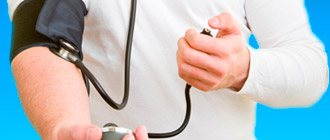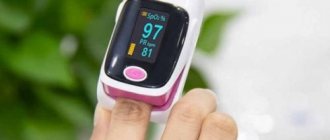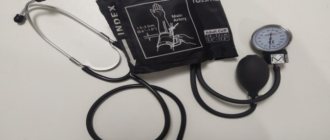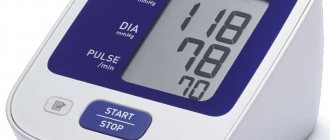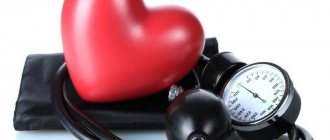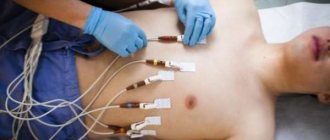The Omron tonometer is a common device for measuring pressure, which has proven itself to be quite reliable and does not give a strong error. The brand is Japanese, and the manufacturer guarantees the high quality of its equipment.
Modern materials used in the manufacture of these tonometers guarantee that the measurement error is completely absent or is no more than 2-3 units, which is insignificant.
Instructions are available for all models of tonometers included with them. It indicates what can provoke significant errors, and these factors must be excluded at the time of the procedure.
On which hand should I measure and in what position?
Blood pressure shows how hard the blood presses against the walls of the arteries. To determine indicators, there are standardized boundaries that indicate the state of human health. They are reduced to two digits of the upper and lower values. They indicate the level of pressure when the heart valve closes, the heart relaxes, and the pulse at the wrist.
For this, a special device is used - a tonometer. Not everyone knows how to use a tonometer correctly. Let's look at the step-by-step instructions below.
As a rule, blood pressure is measured in the upper part of the forearm of the right or left hand, but it is worth clarifying that the indicators may vary. To determine the hand that is best to use, the pressure is measured on both limbs with a break of several minutes. Each reading is entered into the table, and after 10-12 measurements, all minimum values are eliminated. The hand on which higher values were established reflects the correct results.
Posture is also important. If a person is not a bedridden patient, then it is preferable to measure blood pressure while sitting. In this case, the legs should be relaxed, not crossed, the body should be leaned on the back. To get accurate results, you need to relax and sit quietly in this position before the procedure. The cuff of the device should be located at heart level.
Features of choice
When choosing a device for measuring blood pressure, even from the most reliable options, you need to take into account some individual characteristics so as not to encounter the fact that in the future the procedure will be uncomfortable, which will increase the error.
- Cuff size. In all tonometers, this part is adjustable, but if a device is needed to determine pressure for a very obese person or child, then the average size will be unsuitable. You will need to purchase an additional cuff, or you need to choose a model that comes with several replacement cuffs of different sizes. Before purchasing, you should measure your arm circumference in the right place in advance.
- The size of the display should be comfortable for the user of the device. For older people, the larger the numbers, the better. In most cases, they need the device for home use and, therefore, there is no need to choose the smallest one.
- Memory size. If pressure monitoring is needed periodically - only when you feel unsatisfactory, then there is no point in overpaying for the device’s memory, which allows you to save the readings.
Before purchasing the device, you must carefully inspect it. There should be no defects or damage on it. If there are doubts about the proper quality of the device, it should be abandoned.
How often can measurements be taken?
If you have heart disease, patients are interested in questions about how to properly use a semi-automatic or automatic tonometer, and how often they need to measure blood pressure. For those who have to regularly carry out the procedure, devices with automatic cuff inflation are more suitable.
At home, blood pressure is measured 2-3 times a day:
- The first time in the morning, an hour after waking up. Before this, you must avoid drinking coffee and tea, do not smoke or exercise.
- The second time the measurement is carried out in the evening, observing the listed requirements.
- The pressure is measured a third time if there are headaches or malaise.
It is not recommended to carry out the procedure more often, as this may weaken the blood vessels and distort the accuracy of the results.
Electronic automatic tonometer
Measuring blood pressure with different devices has some nuances.
How to use an electronic tonometer:
- the hand must be freed from clothing and a cuff placed on it;
- the hand should be stationary at the level of the heart;
- then press the “Start” button;
- After a while, the results will appear on the screen.
To find out the average value, it is necessary to re-test after 5 minutes.
Semi-automatic blood pressure monitor
You can measure your blood pressure with a semi-automatic tonometer yourself at home.
How to use a semi-automatic blood pressure monitor:
- put a cuff on the arm 3-5 cm above the elbow, secure it with Velcro;
- using a pear-shaped pump, pump air to a value 30-40 mmHg higher than the expected reading;
- then gradually release air at a rate of 2 mmHg per second.
From 3 to 5 measurements are taken on each arm to establish more accurate readings. In the intervals between procedures, it is necessary to bend and unclench the limb several times for better blood circulation. From the data obtained, the average is calculated and recorded in a notebook.
Mechanical tonometer
Measuring pressure with a mechanical device is the most difficult. It is important to approach the process very carefully and monitor the readings on the device.
How to use a mechanical tonometer:
- You need to relax before the procedure. If you come into the house from the cold, you need to warm up.
- It is necessary to take a sitting position, relax your legs and not cross them. Place your hands on a flat surface at heart level and keep motionless.
- A cuff is placed on the arm, the lower edge of which should be just above the elbow. The tonometer dial should be in front of your eyes to monitor the readings.
- Using a hand pump, inflate the cuff with air. The stethoscope is placed on the bend of the elbow, and the heartbeat should be clearly audible.
- The air begins to be gradually released until a tone appears, this is the upper (systolic) pressure. After the tones disappear, the reached mark on the dial will indicate the lower (diastolic) pressure.
- After a couple of minutes, the procedure is repeated, the average indicator most accurately indicates blood pressure. In case of possible heart rhythm disturbances, it is better to entrust the procedure to a healthcare professional.
Pressure measuring device: indications for use
Blood pressure is one of the vital indicators, which is recommended to be monitored periodically even by healthy people. Regular monitoring of blood pressure on a daily basis is indicated for patients with diseases of the cardiovascular system and chronic diseases, including those associated with a sedentary lifestyle. Main indications for use:
- hypertension;
- hypotension;
- arrhythmia (tachycardia, bradycardia, atrial fibrillation);
- diabetes;
- rehabilitation after heart attack, stroke;
- frequent overwork (physical, psychological);
- frequent stress;
- hereditary problems with the heart and blood vessels;
- vegetative-vascular dystonia;
- chronic diseases of internal organs;
- excess weight.
How to measure wrist pressure?
A tonometer that allows you to measure pressure on the wrist is in great demand among hypertensive patients. The device is portable, has a modern design and stores all blood pressure indicators for a long time.
How to use a wrist blood pressure monitor:
- The tonometer is placed on the arm with the display facing up. There should be a gap of 1 cm from the bottom edge of the bracelet to the palm. There is no need to tighten the strap too much, but the bracelet should fit evenly to the hand.
- The patient takes a comfortable position and places his hand in front of him at heart level. Then you need to even out your breathing and relax. The device is activated; you cannot move during the measurement.
Typically, blood pressure readings measured at the wrist are slightly higher than those obtained from the same procedure at the forearm. Manufacturers of devices do not hide this and explain it by the specific location of the arteries on the wrist and their width.
Why are the results different?
We looked at how to use a mechanical tonometer and an automatic analogue. Often a person has a question about the veracity of testimony.
The following factors may affect the correctness of blood pressure measurements:
- The electronic tonometer was used near household appliances (computer, microwave oven) that emit electromagnetic waves.
- During the measurement process, actions can be performed that are not a load for a person, but they are reflected in the resulting indicator - coughing, laughter, changing posture, hand movements.
- Before performing the procedure, the patient did not calm down; any emotions affect blood pressure.
- During the procedure, it is likely that the air pressure in the cuff will change. This is due to pressure on it, intermittent breathing, and active movement of the leg.
- The patient took an incorrect position during blood pressure measurement. Lying down, the upper pressure reading increases, and the lower reading decreases. When sitting cross-legged or without leaning on the back, the pressure level increases.
- The limb on which the cuff is placed must lie on the surface. If the hand is unsupported, both values increase.
- The cuff is not secured correctly.
- The arm on which the pressure is measured is located above or below the level of the heart.
- If a couple of hours before the procedure the patient smoked or drank coffee, the blood pressure increases to ten units.
- The pressure must be measured up to 5 times in a row on the same arm, and if you do not maintain an interval of several minutes between measurements, the result will be inaccurate.
If a person has purchased such a device for the first time, it is better to consult with a medical professional and find out how to use the tonometer.
What causes errors in indicators?
Inaccurate data may be noted when measuring blood pressure in the following cases:
- violation of the rules of conduct during measurement - activity, conversation, watching TV,
- low level of battery charge in the device - when they run out, there may be malfunctions,
- poor quality cuffs - old, they may not create the required level of compression and begin to leak air,
- device problems.
During the day, slight fluctuations in blood pressure are normal. This is not a disease or evidence that the device is faulty.
Recommendations
Often people do not know how to use a manual blood pressure monitor or a semi-automatic device. Let's look at some recommendations:
- People over 40 years of age are recommended to purchase automatic blood pressure monitors; devices on the wrist will not accurately reflect the readings, since the arteries in this area are quite worn out in older people.
- For patients suffering from cardiovascular diseases, it is better to purchase a tonometer that measures not only blood pressure, but also pulse.
- If the device is used by two family members, you should pay attention to models that store the data of two users.
- A tonometer with a fan-shaped cuff does not cause discomfort during use; it fits tightly to the arm, as a result of which blood pressure readings are not distorted.
- The cuff must not be secured over clothing or the device must be turned on until it is worn.
- During the procedure, you should not talk or strain.
- For people with poor vision, tonometers have been developed that pronounce the measurement results, and devices with an intelligent control function are also commercially available. Thanks to special sensors, they give a signal if the procedure is performed incorrectly.
In the article we looked at how to use a tonometer. It is worth saying that the correctness of the noted indicators depends on the correct use of the device. If a person is in doubt, then it is necessary to talk with a doctor and clarify the nuances of using a tonometer.
Wrist devices
Compact electronic models of blood pressure meters that are easy and convenient to take with you. They are also great for people who have chubby hands in the elbow area, as well as increased fragility of blood vessels or diseases of the elbow joint. The cost of such devices is from 1500 to 3000 rubles. All wrist tonometers are characterized by:
- accelerated determination of pressure indicators,
- adjustable cuff from 13.5 cm to 21.5 cm,
- presence of a hand position sensor,
- the simplest possible use of the device.
The device always comes with a case for storage and transportation. Depending on the model, the memory is enough to save results from 60 to 90 measurements.
Such devices usually occupy leading positions in the ranking of the most convenient.
Important! Even very elderly people, for whom other equipment is difficult to operate, can master the control of them.


